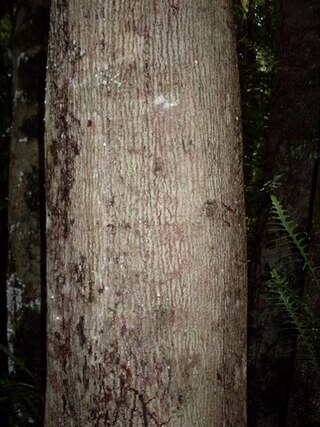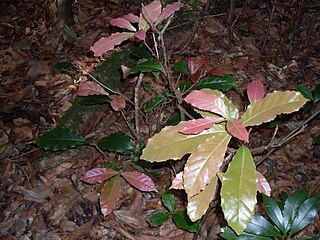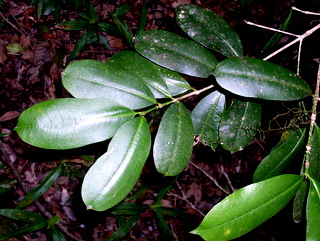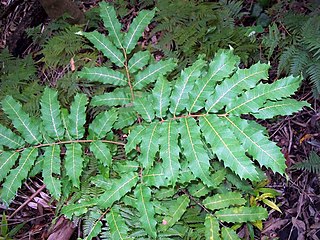
Karrabina benthamiana is a species of rainforest trees, growing naturally in north–eastern New South Wales and south–eastern Queensland, Australia. They have common names including red carabeen, leather jacket, brush mahogany, red bean, pink marara and brush mararie. This species used to be placed in the genus Geissois as Geissois benthamiana.

Cryptocarya glaucescens, commonly known as jackwood, is a rainforest tree of the laurel family growing in eastern Australia.

Emmenosperma alphitonioides, the yellow ash or bonewood, is a rainforest tree of eastern Australia. It grows from Clyde River, New South Wales near Batemans Bay, to Cape York Peninsula in at the most northerly part of Australia. It grows in many different types of rainforest, in tropical, sub tropical and warm temperate rainforests.

Symplocos stawellii, or the white hazelwood, is a rainforest tree growing in eastern Australia. It often grows along creeks in gullies, in tropical and sub-tropical rainforests. The natural distribution is from Gerringong Creek in the upper Kangaroo Valley of New South Wales to the Atherton Tableland in tropical Queensland. It also occurs in New Guinea.

Sloanea australis, commonly known as the maiden's blush, is a rainforest tree of eastern Australia. The range of natural distribution is from near Batemans Bay in southern New South Wales to Cape Tribulation in tropical Queensland. The habitat of Sloanea australis is various types of rainforest; such as littoral, warm temperate, montane rainforest, sub tropical, and tropical rainforests. Often growing in particularly moist areas, such as next to streams.

Myrsine variabilis, synonym Rapanea variabilis, known as the muttonwood or variable muttonwood is a tree of eastern Australia. The range of natural distribution is from near Milton in southern New South Wales to the McIlwraith Range in far north Queensland.

Hedycarya angustifolia, also known as the native mulberry or Australian mulberry, is a rainforest plant of south and eastern Australia. Its habitat is cool gullies and moist temperate forests, often at high altitude. Occasionally it is seen bordering sclerophyll forests.

Polyosma cunninghamii, known as the featherwood, is a small rainforest tree of eastern Australia. It grows in many different types of rainforest, however seldom found in the drier rainforests. It is often seen in the cooler rainforests at high altitude. The range of natural distribution is from Kioloa near Batemans Bay in southern New South Wales, to Maleny in south eastern Queensland.

Baloghia inophylla is a rainforest tree of eastern Australia. It is also known as the brush bloodwood, as it occurs in brushes,, as well as bloodwood, as the clear sap is blood red. Other common names include ivory birch and scrub bloodwood.

Streblus brunonianus, known as the whalebone tree, is a small tree in the fig family. Commonly seen in a variety different types of rainforest, particularly by streams.

Claoxylon australe, known as brittlewood is a common rainforest shrub or understorey tree. The habitat is all types of eastern Australian rainforests. The natural range of distribution is from Eden in south eastern New South Wales to Bowen in tropical Queensland.

Croton verreauxii known as the green native cascarilla is a small tree or shrub growing in dry rainforest and rainforest margins in eastern Australia.

Daphnandra johnsonii, also known as the Illawarra socketwood, is a rare rainforest tree in the Illawarra district of eastern Australia.

Maytenus silvestris is a shrub or small tree growing from Picton, New South Wales near Kroombit Tops, near Gladstone, Queensland. It occurs in dry rainforest, eucalyptus and rainforest ecotone areas. Common names include narrow leaved orangebark, orange bush and orange bark.

Daphnandra micrantha, the socketwood or Manning River socketwood is a rainforest tree in eastern Australia. It grows near streams in various types of rainforest. Restricted to the Manning River and Hastings River valleys of northern eastern New South Wales. Also seen in ecotone areas dominated by brush box and tallowwood.

Elattostachys nervosa, known as the green tamarind or beetroot tree is a common rainforest tree of eastern Australia. Found in all types of rainforest, growing from Paterson, New South Wales in the south to Gympie in south east Queensland. The name Elattostachys refers to "little spikes", a flower feature of other plants in this genus. Nervosa refers to the prominent leaf venation. Beetroot Tree refers to the beetroot red leaves of the new growth.

Mallotus philippensis is a plant in the spurge family. It is known as the kamala tree or red kamala or kumkum tree, due to the fruit covering, which produces a red dye. However, it must be distinguished from kamala meaning "lotus" in many Indian languages, an unrelated plant, flower, and sometimes metonymic spiritual or artistic concept. Mallotus philippensis has many other local names. This kamala often appears in rainforest margins. Or in disturbed areas free from fire, in moderate to high rainfall areas.

Baloghia marmorata is a rare rainforest plant of eastern Australia. It is commonly known as the marbled baloghia.

Cupaniopsis newmanii is a rainforest plant in the soapberry family. It is native to eastern Australia. The common name is long-leaved tuckeroo. A rare plant, with a ROTAP listing of 2RC-. The habitat sub tropical rainforest ranging from Mullumbimby in New South Wales to Gympie in south-eastern Queensland.

Petalostigma triloculare, known as the long-leaved bitter bark is a rainforest tree of eastern Australia. It occurs in the drier rainforests, often on sandy soil derived from granite or sandstone, and is sometimes seen on old sand dunes.


















